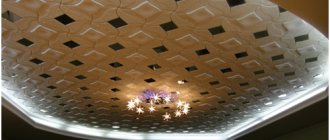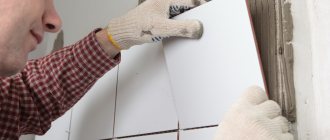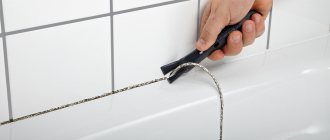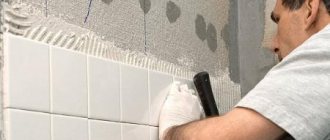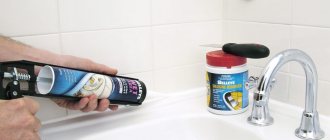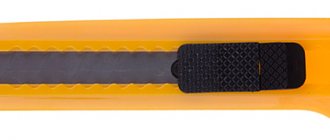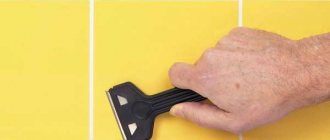Advantages and disadvantages of using sealant
Sealant has its strengths and weaknesses. Among the advantages:
- you cannot make mistakes during the installation process, as the sealant dries quickly;
- does not smooth the surface;
- when laying on a movable base, it will not be possible to apply grout;
- price.
Fundamentally! It is often said that the tiles fell off due to the unreliability of the sealant or glue. In almost all cases, the cause is inadequate preparation of the base. For example, there is no primer, incorrect application of the fixing agent.
How to glue a tile that has fallen off?
The surface of the base is primed and, after drying, finished with the resulting tiles
smaller thickness, gluing it to the surface with a two-component epoxy-based adhesive. On walls with this repair method, instead of epoxy glue, you can use silicone or “liquid nails,” which are unsuitable for floor repairs.
Interesting materials:
Is it possible to grow a plum from a cutting? Is it possible to grow Monstera from aerial roots? Is it possible to grow radishes in an apartment? Is it possible to grow varietal grapes from seeds? Is it possible to grow a cut tulip? Is it possible to grow thuja in an apartment? Is it possible to take cut grass to the forest? Is it possible to bury coleus? Is it possible to bury the aerial roots of an orchid when replanting? Is it possible to pour the foundation twice?
Movable and fixed base
The sealant is suitable for both moving and fixed bases. Here it is worth mentioning separately about materials with increased mobility. This is wood, drywall and others. A silicone-based product works better, since the glue hardens very much over time, and the tile may fall off. The sealant retains elasticity and firmly fixes the tiles to any surface: the floor, walls, ceiling. Compensates for all bulges and deformations of the base.
Types of sealants
There are different types of sealants. Which tiles should I glue them on?
- Neutral silicone ones do not have a strong vinegar aroma like alkaline ones. They are good for processing cracks and seams at the very end of the work process. Acidic ones are cheaper. Used in working with ceramics, wood, plastic. They are not suitable for metal, because the surface will oxidize as a result of the vulcanization process.
- Acrylic sealants are no worse in composition than the first ones. They also have a long service life and are resistant to UV radiation. The temperature range is smaller: from 20 to 70 degrees. Elasticity is also lower.
Fundamentally! It is necessary to pay attention to moisture resistance, and not just to the base of the composition. There are those that cannot be used in rooms with high humidity.
- Polymer ones are good for replacing old seams due to their high elasticity and resistance to damage.
- Combined ones, consisting of acrylic and silicone, are perfect for connecting surfaces, including ceilings. Such connections are highly durable and last for a long time.
Rubber, bitumen, and silicate sealants are least often used. It is possible to choose the appropriate color.
Sealant colors
Popular manufacturers
The fundamental aspect of choice is quality and ease of use. The following brands have proven themselves to be excellent:
- "Moment" - silicone sealant. There are Russian and foreign production. Suitable for work in wet areas. Release form: tubes.
- "TYTAN" is a high-quality sealant. There are acrylic and silicone , volume less than 300ml.
- "Ceresit" is used mainly by experienced builders. Country of origin: Germany. The only restriction: do not use on food surfaces.
The use of tile sealant can be. And from time to time it is a balanced option. For example, when installed on flat and movable bases. Silicone can be used on tiles if they have fallen off the cement base. Provides strong fastening for a long time.
How to glue ceiling tiles in a few seconds
If you have ever glued ceiling tiles, then you can imagine how difficult this work is... Yes, it seems that nothing is simpler - apply the glue and press the material harder to the ceiling, and that's it. But in reality everything is much more complicated. Yes, yes, firstly, hands raised up quickly become numb (there’s not just one tile, there’s a lot of it), and secondly, the material doesn’t want to “just stick.” Agree - this is tiring and complicates the work. Let's reveal the secret of how to really simply and quickly glue tiles to the ceiling.
Surface preparation
There are two aspects that will ensure that the process of gluing ceiling tiles is simple. And the first is careful and proper preparation of the surface to be glued. Yes, in some cases, tiles can be glued “as is”, over old whitewash or old paintwork... But not always.
Remember: you can glue ceiling tiles over old materials only in one case - when this old material adheres extremely firmly to the black surface. That is, the whitewash does not crumble, the paint does not fall off in flakes. In all other cases, the surface will have to be prepared. Otherwise, all your efforts will go to waste: tiles installed even with the most powerful and expensive glue will not last long on the upper horizontal surface of the room.
How do we prepare the surface? It's simple: if the ceiling is whitewashed, then you need to rinse it thoroughly and simultaneously remove all peeled layers of coating. You can only leave those that stick tightly to the concrete. Everything else must be deleted.
The painted ceiling should also be checked for peeling paint and removed if any. And you can also wash it to increase adhesion by removing any fatty deposits, etc. The surface can also be primed. Remember - each time the ceiling (after washing, priming) must be thoroughly dried before starting the next stage of work.
Important! If very deep dents or unevenness have formed on the ceiling during surface preparation, it is recommended to putty them.
Only after careful preparation can you begin gluing the tiles. And we move on to the second aspect of successfully gluing tiles quickly and easily.
Choosing glue for work
One of the key parameters for success is the correct choice of adhesive composition. Ceiling tiles are a material that continues to be in demand and will not leave the market for many years. That’s why there are plenty of adhesives for this material on store shelves. How to choose the one that will not complicate, but will simplify and speed up your work?
Different types of adhesive for ceiling tiles
If you buy low-quality glue, you will suffer during work in the literal sense of the word. The tile will need to be pressed firmly against the surface and should be kept in this position, and there is no guarantee that 5 minutes after you remove your hands, it will not come off the surface from one edge or another. And only good glue will allow it to be securely and firmly fixed to the ceiling the first time. So, the requirements for good glue:
- high adhesion;
- fast speed of hardening and setting;
- moderate consumption.
Most often, polyvinyl acetate glue or adhesive mastic are used for gluing tiles. However, buying almost any of these compounds is a lottery. There is never a guarantee that the composition of one type or another purchased by you will easily fix the tiles to the ceiling without prolonged pressure. What composition will allow you to quickly glue the tiles? It turns out there are two of them.
For liquid nails
Liquid nails are a type of construction adhesive that is characterized by rapid hardening and excellent fixation ability. This composition is made on the basis of synthetic rubber and polymer additives, as well as special clay, which is a filler.
This glue quickly and easily glues a variety of surfaces. It is also suitable for gluing ceiling tiles. It is convenient and easy to apply, and with moderate consumption, pointwise, around the perimeter and in the middle of the tile from the wrong side. Then the tile with glue is pressed against the surface of the ceiling and is held in this position for only a short time. The glue will set quickly, but will dry completely within 12 hours.
Application of liquid nails
For silicone sealant
You can glue the tiles quickly, without a long wait for setting, using silicone sealant. Yes, you heard right: this adhesive composition will allow you to quickly attach the tiles to the ceiling.
Silicone sealant is a composition with a fairly thick consistency, created on the basis of so-called silicone rubbers. It hardens quite quickly, and at room temperature: as soon as you squeeze the sealant out of the tube, it begins to polymerize. Typically, the material is used for sealing seams and joints, cracks, filling some cavities in order to seal a room, some place, and protect them from environmental factors. However, the composition has excellent adhesion and good adhesive properties, therefore it can also be used as an adhesive composition.
Silicone sealant
The sealant is not afraid of water, elastic, and quite resilient. It has very high adhesion to a wide variety of materials - the composition will easily attach foam tiles to the whitewashed surface of the ceiling. And the sealant is resistant to environmental factors.
Important! In order for the tiles to stick well, you need to buy silicone sealant.
When gluing tiles, the sealant is applied in exactly the same way as regular glue: along the perimeter of the element and to its middle from the wrong side. Then the tile is pressed against the ceiling and is held pressed against it for a short time.
Using liquid nails or sealant will certainly increase the cost of finishing the ceiling. But it will reduce time costs and even make you less tired while working. Whether you use the ingredients or not is up to you. But if you are in a hurry and don’t want your hands to be overly tired after finishing the upper horizontal surface, then we recommend trying these particular adhesive materials.
What is the difference between silicone adhesive and sealant?
In fact, there are no significant differences between these 2 products. The composition of both glue and sealant is the same - there is no fundamental difference in the chemical structure of silicone. The quality of the product is also identical. The only difference is the scope of implementation:
Adhesives are products that are primarily used to glue small objects together and occasionally seal tiny seams. Also, adhesives are packaged in small pipes and tubes and do not require a construction gun for use. In general, silicone adhesive is intended mainly for small volumes of work that do not require professional abilities or equipment. Sealant is a product used to seal seams. These seams are quite huge, in other words, they have huge linear dimensions - structures made of plastic, glass, metal, etc. To apply a composition such as silicone adhesive-sealant, a construction gun or other similar equipment is required - this is necessary, since sealants are used for huge volumes of work that human hands cannot handle.
How to quickly and efficiently glue ceiling tiles without glue, even on whitewash
At first I glued the ceiling tiles with a special glue for them. He swore all over because it is inconvenient to glue, since each tile must be held and pressed until your hands fall off or wait until it sticks.
And in the end I got tired of it all, and I began to experiment. I tried everything until I found a very fast and high-quality method. You may not believe it, but you can even glue it to whitewash and not wash it off. This glue eats into the whitewash all the way to the concrete. And now I will share what kind of miracle glue this is.
After my diligent experiments, a discovery was made and it turned out to be a simple “SILICONE SEALANT”.
How to quickly and efficiently glue ceiling tiles without glue, even on whitewash
No other, but only this one. It has the ability to penetrate deeply into the pores of the tile, as well as through the whitewash layer to the concrete.
It was experimentally verified that one tube can be enough for about ten square meters.
But before starting work, it is still best to wipe the ceiling itself with a damp cloth to remove dust from the surface or anything that may peel off. Wait for everything to dry, since it is advisable to glue the tiles only on a dry surface.
How to quickly and efficiently glue ceiling tiles without glue, even on whitewash
So, we take the ceiling tile and apply silicone sealant to the base along the edges in dots and crosswise, and then glue it to the ceiling.
How to quickly and efficiently glue ceiling tiles without glue, even on whitewash
Silicone is able to hold the slab like a suction cup until it hardens thoroughly.
The method is also convenient because silicone can be applied to several tiles at the same time, and then glued one after another, since silicone tends not to harden for a long time, so the working time is much reduced.
Everything was tested not by me alone, but also by other people with whom I shared my experience. They were very pleased with the result and speed of work. I give a 100% guarantee that nothing will fall off over time, everything will last a long time.
Can I use silicone sealant in the bathroom?
Many remodelers only use this sealant for bathroom work, and for good reason. Silicone sealant is available in 2 types - acidic and neutral. The first one is cheaper but when used it releases a sour smell (reminiscent of vinegar). When using a neutral one, it does not awaken strong odors that can lead to headaches from time to time.
Laminate sealant
Acrylic sealants are used to seal voids and joints in the laminate.
Dirt and dust often collect at the joints of laminated panels; in addition, these places receive moisture. One of the effective methods of combating moisture is the use of a special sealant. According to experts, the most suitable sealant for laminate flooring is a silicone product. It is distinguished by high technical and operational qualities. Germany is the leader in the production of silicone sealant for laminate flooring; they have created a product with high moisture resistance. You can apply sealant even without specialized skills. Note to consumers: this sealant does not release toxic fumes into the air.
Acrylic mixtures are also used to fill voids in laminate flooring. This sealant can be painted after final drying. The acrylic seal will withstand any temperature changes. Colored laminate sealants are used to make it easier to remove sealant residue from the surface.
Plywood sheet flooring
Wood sealants can be painted in characteristic colors.
It should be understood that the basis for many floor coverings - laminate, parquet, linoleum - are plywood sheets. Plywood becomes a real savior when your floor has a lumpy, unsmooth surface. Sheets of this material, laid under the main coating, serve as an excellent leveler. Plus, such work can be done independently. So, when you choose rather expensive laminate or parquet tiles as a floor covering, it is advisable to strengthen and level it from the inside with sheets of plywood, so that in the foreseeable future you will not have to spend money on restoration. But plywood leveler flooring also requires a base. As a rule, it becomes a concrete screed, completely dried and waterproofed. The joints between sheets of plywood also need to be sealed with sealant. In cases where plywood sheets are laid under the laminate, it is necessary to take care of the substrate from the thermal insulation layer: it will act as shock absorbers for the laminate panels.
Parquet sealant
A wooden floor will give unprecedented warmth to your home. But you won’t be able to admire the exquisite pattern of the wood for long, since wooden floor coverings are not very durable; after some time from the start of use, the wood becomes very vulnerable to aggressive external influences. Gaps are unpleasant consequences of wear. You can prevent the destruction of aristocratic parquet tiles or parquet using sealed putty. Most often, a concentrate based on acrylic dispersion is used as a sealant for parquet; it has excellent adhesion to wood.
Again, don't forget about the plywood flooring. If the floor surface is relatively flat, then a plywood layer 10 mm thick will be sufficient; for a lumpy floor, use a sheet no thinner than 12 mm.
Composition and properties of silicone adhesives
Silicone adhesive has become popular due to its unique combination of properties and parameters that other types and types of adhesives do not have. It can be used immediately for bonding and sealing.
READ How to cover bathroom walls other than tiles
Main characteristics and properties of the substance:
- Moderate thickness. The adhesive mixture allows it not to spill over the surface, while at the same time penetrating into inaccessible areas and areas. It easily fills cavities and bulges in the materials being bonded.
- Wide range of implementation. A wide variety of types and types of materials are available for gluing: plastic, wood, glass, ceramics, metals, tiles , rubber, etc.
- Health safety. Silicone-based adhesive is natural and non-toxic, and complies with environmental and safety standards.
- Simple and easy to use. The glue is simply applied and does not flow; it does not require any special abilities or experience.
- Quite rapid polymerization. The adhesive joint hardens within 2-3 hours; use can begin a day after application.
- The perfect result. The seam is transparent, waterproof, elastic, inert to temperatures and ultraviolet radiation. Additionally, the glue can have disinfectant and fungicidal properties.
- Reliability. Silicone adhesives have all the features declared by the manufacturers. They are reliable, strong and durable.
Use of chemicals
Let's look at how to remove sealant from tiles using the means described above. You will definitely need to prepare personal protective equipment, including a mask and rubber gloves. It’s good if you can ensure constant ventilation of the room - if there are no other ways to “drive” the air, a standard floor fan is enough. It is necessary to cover with tape those places where there is a risk of removing something that does not need to be removed. Regular stationery tape is absolutely sufficient. For gel preparations, it is also necessary to first prepare the spatula and brush used for further application.
If you prefer the aerosol option, then you carefully shake the canister several times, then apply a thick layer of solvent to the place where unwanted contamination appears. You should wait about half an hour before removing the sealant from the tiles. Then carefully go through with a spatula, carefully wipe the surface with burlap, removing any residue. In some cases, once is not enough, then the procedure must be repeated until the result is satisfactory.
An excellent approach is used in cases where a gel-type solvent is used. First you need to thoroughly dry the surface intended for applying the substance. If there is water there, the gel will not be as effective, but you will have trouble scrubbing the sealant off the tiles. After this, use a brush to apply it evenly to the area of contamination. Now you wait until the silicone softens thoroughly. This is checked by simply trying to pry it off. Next, use a spatula to collect the remaining silicone and thoroughly rinse the surface with water so that no traces remain.
There is no fundamental difference between using an aerosol or a gel, it is solely a matter of your convenience.
Silicone - useful information
Silicone is an organosilicon high-molecular polymer, invented in the middle of the 20th century and now intensively used in various fields of human activity. It is indispensable in the chemical and food industries, aviation and automotive industries, medicine and cosmetology, electronics, technology and agriculture. This substance is widely used in the production of silicone glue, which provides reliable and strong connection of a wide variety of materials to each other.
The characteristics of silicones directly depend on their chemical composition and structure. They are resistant to water and temperature, resistant to ultraviolet radiation and radiation, dust and pollution, and inert to microbes and chemical substances. Silicones retain elasticity and strength under temperature changes and sunlight, and are not susceptible to water of any composition - fresh and sea. They do not oxidize in air and are not affected by heat, wind and cold. With all this, this substance has an affordable price and wide distribution.
Silicone adhesive sealants
Flexible silicone caulk is made from silicon, which occurs in the form of quartz or sand. At first, polymers are made from the material, which act as the base for the sealant. The starting material determines the main characteristics of the sealant. The main feature is the highest stretchability, which allows the sealant to be used for working with moving joints. The material compensates for deformation at the joints and does not collapse under external influence.
The sealant can be used for domestic and industrial purposes, as it is able to withstand ambient temperatures ranging from 50 to 200 degrees.
Special types of sealants with increased heat resistance can be heated to 300 degrees. Also, the possibility of widespread use is associated with the resistance of the sealant to the adverse effects of ultraviolet rays, cleaning agents and humidity.
What kind of glue do they use?
The aggressive environment of the bathroom limits the craftsmen in the choice of product. Options for working with polymers in wet conditions should be combined with ceramic wall surfaces. To solve the question of how to glue plastic to tiles, you need to study the popular types of compositions.
Kleiberit 363
Universal adhesive based on synthetic resins holds well in high humidity conditions. Does not emit toxic substances when temperature changes. The inexpensive solution is sold in tubes with a convenient spout. The product helps to fix plastic corners or polyvinyl chloride panels on the tiles. The adhesive mass dries quickly.
Universal adhesive for the bathroom Source oradestiri.ro
Which silicone glue is better and how to work with it
With the development of technology, new materials endowed with unique qualities and useful properties come into daily life. Such substances include silicone . It is used everywhere - in construction, decoration and repair, industry, technology and production, in service, handicrafts and in everyday life. This glue is available in a variety of materials in structure and quality: fabric, paper and leather, rubber, tiles and glass, plastic, metal and ceramics. How to choose and use it?
How to solve the problem of falling tiles?
Sometimes people encounter a problem - a tile has fallen off. If this happens for the first time, then natural questions arise: “How to glue the fallen floor tiles?”, “How to glue the fallen tiles on the floor?”. There is no need to worry, there is a solution.
If part of the tile breaks off, then the remaining fragments must be removed yourself; this can be done using a screwdriver and a hammer. Use the sharp part of a screwdriver to pry off the tile, and gently hit the handle with a hammer.
The next stage is to take the same tile and, after cleaning the floor, lay it on sealant or glue. There is no need to spread it over the entire area. If it is not possible to find the same tile, then there is no need to touch the whole fragments, all that remains is to put the fallen part on the glue.
But in this case, a crack will be visible, nothing can be done about it. The maximum is to cover it with grout to prevent dirt from getting there.
Glue selection
Several types of glue are suitable for the restoration of silicone products. To choose the right composition, it is recommended to familiarize yourself with the characteristics of the available options and settle on the appropriate one, taking into account the characteristics of the product. As a rule, silicone sealant or cyanoacrylate glue is used to connect parts. Such solutions reliably eliminate defects and firmly join surfaces.
A good gluing result is ensured by an adhesive that meets the following requirements:
- elasticity and strength - the composition forms a seam that is not damaged by external influences and vibration loads;
- optimal consistency - the thickness of the mixture to penetrate hard-to-reach areas and fill small cracks;
- ability to withstand high temperatures - just like silicone itself, the glue must withstand heat without loss of properties;
- ease of use - convenience is affected by the packaging of the substance and the method of application;
- rapid polymerization - a high-quality solution can harden in a couple of hours.
Composition selection
Since silicone-based sealants differ from each other in different properties, it is necessary to choose this material taking into account the scope of its use.
TEST. How to glue ceramic tiles to silicone TESTING We glue and tear off different surfaces!
- Universal. A type of glue that is suitable for external and internal work on fastening elements and sealing them, for crafts and repairs. The sealant does not change its properties at any temperature, which allows it to be used for gluing heating radiators and heating devices. This composition allows you to glue elements that during operation experience various deformation loads - window and door openings, tiles and tiles, products made of ceramics, polymers, plastic and glass.
- For outdoor work. In addition to the main components, it contains an acetic hardener, which causes its characteristic odor. Designed for outdoor work. Can be used to join a variety of materials, including plastic, pipes, rubber, fabrics, glass, wood and ceramics. When processing certain metals, the adhesive composition can provoke corrosion, which is why it is rarely used for gluing metal elements.
- Silicone glue -sealant. A type of silicone adhesive that can be used to seal seams that are regularly exposed to moisture and liquids. Only with the help of silicone sealants can you obtain a reliable, strong, durable and moisture-resistant connection.
- Aquarium. A type of non-toxic glue that is widely used in aquarium repairs. It is resistant to water and ultraviolet radiation. Before purchasing an adhesive intended for work in this area, you need to make sure that the packaging is marked with a fish.
- Sanitary glue. A special silicone composition that prevents the appearance of fungi and mold due to the presence of bactericidal components in the composition. Mainly used in rooms where high humidity prevails - in bathrooms, kitchens and toilets.
- Automotive. Adhesives belonging to this group are widely used as sealants and gaskets in the repair of cars and various equipment.
- High temperature adhesive. Available in the form of silicone sticks, which are melted during use by exposing them to elevated temperatures. This is done using a heat gun. The main advantages of this composition are its viscous sticky structure, flexibility after hardening, and resistance to aggressive influences.
READ How to lay floor tiles correctly
Question for the experts: can tiles be glued to silicone?
Moderator: Nimh69
Question for the experts: can tiles be glued to silicone?
writer » May 12, 2015, 10:02 pm
Re: Question for the experts: can you glue tiles to silicone?
tiler in Minsk » July 17, 2015, 11:04
Re: Question for the experts: can you glue tiles to silicone?
plitka-brest.by » March 24, 2016, 12:25
Re: Question for the experts: can you glue tiles to silicone?
aykon » Mar 30, 2016 10:51 pm
Re: Question for the experts: can you glue tiles to silicone?
plitka-brest.by » March 31, 2016, 12:46
here we are talking about gluing tiles onto silicone at home to a concrete slab or plaster))) somehow I doubt that I would glue tiles to silicone at home)))
Re: Question for the experts: can you glue tiles to silicone?
Master » 07 Apr 2016, 14:52
It is possible and sometimes even necessary! I glued it to silicone more than once or twice. It holds up well and is difficult to remove later. Example: a neighbor, probably a 70-year-old grandmother, had a tile above the stove fall off in her kitchen. It was glued on cement “cakes” about 30 years ago. The tiles fell off, but the cakes remained. In order not to knock them down, I glued them on silicone, but glue did not work; a layer of glue would lead to the fact that the plane would not be even. The new glued tile stuck out relative to the old one, but when I glued it to silicone, everything was smooth. It's been a year now and everything is fine. Recently I came in to take a look.
Sometimes, not having a special glue for deformable bases, the glue on silicone tiles, on metal, for example, sticks so that you can’t tear it off! The main thing is to know how to glue! Otherwise they’ll drop a drop on the tile and stick it to the dust. then it holds up like crap. And if you rub it into the tiles and into the base, and then glue it, it will last for a hundred years.
Re: Question for the experts: can you glue tiles to silicone?
Nimh69 » Apr 21, 2016 10:42 am
Re: Question for the experts: can you glue tiles to silicone?
writer » 02 May 2016, 13:33
Re: Question for the experts: can you glue tiles to silicone?
plitka-brest.by » 02 May 2016, 13:42
Many people here did not understand the essence of the question:
If you are gluing an entire bathroom, then, of course, it is very stupid to do it with silicone.
And if 2-3 tiles that have come loose are glued to silicone and sealed, then this option may very well be possible.
Re: Question for the experts: can you glue tiles to silicone?
Sergey » June 04, 2016, 11:35
Features of silicone glue
Silicone adhesives differ from each other primarily in composition. In addition to the main components, manufacturers add various catalysts, hardeners, fillers, and rubber. These adhesives differ from others in that the base component in them is silicone.
Even in those distant years, when enterprises were just beginning to establish silicone production, it had already become widely used in various fields. The base component provided silicone glue with a lot of useful properties, making it a multitasking, versatile and reliable material to use. It allows you to glue objects from any materials. It is also successfully used for sealing seams. Many manufacturers offer a special type of silicone adhesive called sealant, although in terms of its composition and functions it is the same compound.
What is better grout or sealant?
Like grout, caulk is an elastic material used to seal tile joints, sealant protects the joints from excessive water absorption and from staining in the joints. But unlike a material such as grout, sealant wears out over time and requires replacement.
Interesting materials:
Which city did Prince Igor Svyatoslavich rule? How many citizens should be part of the initiative group to hold a local referendum in the region and the city of Minsk? Which metro shopping center is the city? Which sea washes the city of Cancun in Mexico? Which sea washes the city of St. Petersburg? What title did the city of Astana receive? What date will be City Day in Irkutsk? What date is City Day in Yoshkar Ola 2022? What date is City Day in Omsk? What city code is 952?
Scope of application
A distinctive feature of silicone sealant is its versatility, which allows it to be used for various outdoor repairs. This type of glue, whose properties are related to its chemical formula, is suitable for:
- sealing seams on vinyl siding;
- sealing connections during roof installation;
- repairing stone tiles that can peel off at the base;
- sealing joints on window frames;
- sealing seams on drain pipes.
Sealants are also suitable for indoor use. They can be used, among other things, for:
- sealing areas that will be affected by temperature changes;
- sealing joints and seams on window sills and kitchen countertops made of natural stone or artificial composite material;
- sealing joints between wall and ceiling, wall and floor when installing plasterboard structures.
Multi-colored and transparent silicone-based compounds are often used in the bathroom. In this room they allow:
- seal the seams between the bathtub or shower stall and the wall;
- strengthen the joints of sewer pipes;
- seal the seams in areas where plumbing fixtures adjoin the wall;
- install the mirror.
VALMEXINsc38
VALMEXINSC38 adhesive from the German company Rema is intended for express repair and restoration of silicone products, regardless of their size and condition. The solution is economical to use and easy to use. VALMEXINsc38 is made on the basis of three solvents.
Video description
Bath border.
Installation on an old bathtub
The procedure begins with removing the outdated corner. Use a spatula or knife to pry up the part, carefully disconnecting it from the bath. The joints are cleaned of old sealant. Mechanical scraping can damage the enamel surface, so it is better to use special solvents.
The sides and perimeter of the wall are treated with a mold repellent. The antiseptic eliminates and prevents the development of microorganisms on the ceramic wall. The space is degreased and covered with masking tape. The gaps between the bathtub and the tiles are filled with fresh silicone sealant, and the excess is removed with a spatula. The material dries in 2-3 days.
Carefully remove the corner Source market-crimea.com
Using a meter, measure the length of the sides that are pressed against the wall. Pieces of corners are cut out according to the parameters, taking into account the side plugs. The parts on the bends are placed first, then they move on to the main ones. Glue is applied to plastic and tiles. The elements are pressed against the product for the period specified in the instructions. Alignment is carried out using a laser level. After complete drying, grout the cracks.
Installation technology Source stroykaguru.com
Installation on a new model
The sides of the bathroom are cleaned and degreased with alcohol. To prevent glue from getting on the ceramics, cover a distance equal to the height of the curb with construction tape. Painting material is applied around the perimeter of the bowl near the wall. Fill the cracks with silicone sealant and dry for 2 days.
Installation technology Source stroykaguru.com
The corner is cut according to the parameters of the bath. The fixing composition is squeezed onto the plastic and onto the tiles. The element is quickly and firmly pressed against the tile, allowing time for initial setting. After polymerization, you can begin to seal the cracks.
Can it be glued to silicone sealant?
Offhand: use it as a sealant, that is, for its intended purpose (sealing joints: when screwing on faucets and other plumbing fixtures, between a bathtub and a wall, when installing a sink in a countertop, etc.).
Secondly, as an adhesive, for example, silicone sealant perfectly holds mirrors glued to furniture facades.
You can combine these two properties (for example, I glued the baseboard to it around the perimeter of the bathroom).
Just cover the cracks (if the sealant is, for example, white) to make them less noticeable (but here dry building mixtures are more convenient).
favorite link thank MaiAsim [30.7K]
The main purpose of using silicone sealant is sealing. But in fact, the scope of its application is incredibly wide. The most popular surfaces for which the sealant is used are wood, metal, and stone. Plastic is also quite popular, but in this case much depends on the type of material and additional conditions such as humidity and temperature.
If we take silicone sealant as a whole, without going into details of the scope of application of each brand of product, then it is used:
- for sealing holes between seams (when installing windows, shower stalls, etc.),
- The parts are treated with silicone for a good connection,
- used as glue (silicone is good for fixing various parts, especially those that are exposed to water or moisture)
For the use of silicone for processing plastic, there are special brands of sealant and this circumstance should be taken into account. In addition, there is universal sealant, plumbing sealant and others. Let's look at the cases in which each of them is used:
- neutral silicone sealant - universal mixture. This sealant is used in most jobs. It is not suitable unless for some special tasks when special conditions are required;
- silicone transparent sealant - due to its colorless composition, it is relevant when working with materials that are in one way or another in plain sight, for example, windows, aquariums, and the like;
- sanitary silicone sealant - intended for places with a high probability of mold and mildew development. Therefore, it is relevant in bathrooms and kitchens;
- silicone sealant for aquarium - despite the name, it is still suitable for a larger number of works, for example, sealing pools or for windows;
- silicone food sealant - only this type of sealant can be used on surfaces that come into contact with food. Used for kitchen countertops and the like;
- high-temperature silicone sealant - only this type of sealant can be used to seal seams in areas exposed to elevated temperatures. Sometimes you need to glue a window on the oven door or use sealant in a place where the sun will shine in the summer (and in the open sun the temperature is such that the asphalt melts)
In addition to all of the above, people find various uses for this composition, so the list can be supplemented almost forever.
favorite link thank Klen [8.7K]
For its intended purpose as an insulator for liquid or gaseous media, increasing the vibration resistance of a structure, waterproofing.
Silicone sealants are one of the progressive inventions of chemists of the 60s. These are polymer compositions based on low-molecular rubbers, curing (vulcanization) of which occurs at room temperature in the air and due to air moisture. Their main properties: inertness to aggressive environments, water, air, heat resistance and frost resistance from – 60 to 300, resistance to solar radiation and UV. Elasticity (rubber is rubber).
They are completely different in chemical composition and each must be used for its intended purpose:
- 1-component – acidic and neutral. This is the most common group. They are cured by air moisture in a thin layer of up to 10 mm.
Acidic, so-called “acetoxy”. With a strong vinegar smell. Causes corrosion of metals and destroys cement.
Neutral - “methoxy” or “alkoxy”. They have a slight odor. More expensive than acidic ones.
- 2-component or “compounds” Vulcanization occurs when mixed with a catalyst. These sealants are mainly used in industry.
By purpose they are divided into construction, special and automotive. Manufacturers most often clearly indicate the main application in the names and on the packaging. For example, sanitary ones contain a biocide against mold and fungi. They are used in damp rooms, for plumbing when connecting pipes. Under no circumstances should they be used to seal aquariums and terrariums. High temperature or heat resistant sealants cannot be used where there is vibration or moving joints because they are not true silicone sealants, but silicates. They contain liquid glass - sodium silicate, and not rubber.
Silicones are good helpers, but you shouldn’t use them thoughtlessly everywhere. They have a number of disadvantages. Many contain harmful substances, so their use is limited in children's institutions. Do not apply or paint on wet surfaces. Very poor adhesion to plastics - PE, polypropylene, polycarbonate, fluoroplastic. Windows are often sealed with silicone. While this is an ideal sealant for wooden frames, it is bad for plastic slopes. In a year, two windows will begin to whistle if primers are not used to enhance the adhesion of the sealant to the plastic.
READ How to glue foam to waterproofing
favorite link thank Kim Jong-un [301K]
Sealing seams and joints, this also applies to bathrooms and windows and roofing work.
Again, sealing joints, for example, sink-wall, sealing threaded connections, silicone tow sealant (not for everyone, of course, but a working option).
I assemble PVC sewerage using silicone sealant, coat the sealing rings with it, the benefit is double, the ring is lubricated and the pipe fits into the socket more easily, additional sealing.
Glue on silicone sealant (you need white) baguettes on the ceiling
(ceiling plinth) this is especially effective (effective) in damp rooms.
By the way, ceiling tiles can also be attached to the same sealant.
Thanks to the sealant along the way, you can hide trimming flaws in the corners and voids (cracks) wall-baguette (bottom), baguette-ceiling (top).
onto silicone sealant (this option is so-so, but some people use it).
Even a small mirror can be “placed” on the sealant.
favorite link thank Elden [51.2K]
1) As a sealant, i.e. to eliminate leaks or leakage of water and other liquids from or to another place. In principle, this is its most common use. For example, seal corners and joints in the bathroom, coat the gasket during installation, etc.
2) Like glue, namely to stick , but here you need to look at the composition and what it is suitable for. Personally, I glued the molding on the car using silicone.
3) The quality of the gasket or seal. This is when there is no suitable product, for example, when joining two parts, it is necessary to provide protection against leakage.
4) As a putty to fill any cracks or dents.
add to favorites link thank Alexander Andreevich [3.9K]
Filling cracks, joints, seams, etc. Especially where an elastic seam is required;
Sealing from liquids and gases (gaskets, coatings, etc.);
Making molds; (I also made a varnish out of it to make it easier to separate the cast from the mold)
Manufacturing of products resistant to hot water, steam, acids, alkalis, and solvents.
How to glue ceiling tiles to whitewash without removing it?
We want to glue ceiling tiles onto the old whitewash in the bathroom without removing it, what is the best way to do this?
comment to favorites Kim Jong-un [412K] 6 years ago
I’ll tell you how I do it, it’s almost not “by the book”, but it works.
First, you need to decide what kind of whitewash you have on the ceiling; if it’s chalky, then it’s better not to risk it.
The only binder for such whitewash is chalk, and chalk has weak adhesion, it barely holds itself together.
If the whitewash is lime, then everything is fine, of course it should not “hang” when moving away from the base, it should stick well, or at least not badly.
I will not recommend “standard” polymer glue, such as “Dragon”, “standard” for polystyrene foam tiles (or ceiling tiles, as you call them).
The fact is that when working with “Dragon” or similar glue, you need to apply the glue to the ceiling tile, then press it (the tile), tear it off and press it again to the ceiling.
As you understand, this is not acceptable in our case, the lime will fly off.
I usually buy white silicone (sealant) “Moment”
for such work, there is no need to tear off anything, plus the same white silicone will clog the seams and corners of the ceiling tiles.
How to glue ceiling tiles to whitewash
We've sorted out the glue, now we need to take a damp cloth, the wet one closer to the dry one, and carefully remove the dust from the ceiling.
Next, as conveniently as possible, I glue from the left corner of the bathtub farthest from the exit; if you want, glue according to the “primer book”, that is, find the center, draw a line and start from the center to the edges.
I apply silicone to the tile in a dotted line, along the entire perimeter and a couple of drops in the center of the ceiling tile.
It is important to immediately remove excess silicone with a dry or slightly damp cloth.
Silicone "Moment" perfectly glues the tiles to any surface, you don't need to hold the tiles at all, just apply them to the ceiling, lightly press them down around the perimeter and in the middle, and that's all.
At the end of the work on the ceiling, we glue a baguette around the perimeter and work with the same “Moment”.
If “Moment” is not on sale (silicone is popular, sometimes it is not available), then buy “Expert” silicone and there are no questions about this silicone.
It is better to buy a “gun” for the sealant, in principle you can do without it, the square footage in the bathroom is not large, only 2.25 square meters, you can squeeze the sealant onto the tiles with the handle of a hammer.
Tiles with silicone sealant
Properties of sealant for plasterboard joints
Acrylic sealant has properties that allow you not only to align joints, but also to perform other useful functions.
- the seams between the sheets filled with such material become practically airtight;
- the sealant seems to “glue” the sheets of drywall together, making the joint an additional connection;
- the gaps filled with sealant will serve as an expansion joint, which is important when moving walls, since the material is more plastic compared to putty; The process of filling gaps with sealant
- acrylic sealant has excellent heat resistance (temperature range from – 40 to 120 degrees), it is not afraid of direct sunlight and is safe for health;
- the material has high adhesion, especially when applied to gypsum boards. It can be used to repair a crack in a sheet or carry out other repair work.
However, it is not recommended to use such material in damp rooms, since acrylic sealant does not withstand exposure to water. After sealing the seams and drying the mixture, the areas can be covered with putty or you can begin finishing the plasterboard surfaces. Important to know! The quality of the sealant in most cases depends on the manufacturer; it is best to pay attention to the products “Titan”, “Soudal” or “Moment”. The latter, despite its low cost, has acceptable quality. At the same time, do not forget about expiration dates, which also need to be checked! How to seal seams in drywall with acrylic sealant? And what will be required for this?
How to remove silicone sealant from tiles
The solution to the problem is usually to wash off the silicone sealant from the tiles It is imperative to remove all traces, since this material darkens over time, reducing the decorative aesthetics of the tile.
Purpose of using silicone sealant
The dense, viscous texture of silicone sealant is complemented by the amazing ability to stretch with virtually no tearing.
It consists of a base filler, the role of which is given to silicone rubber. In order to speed up hardening and increase strength, an amplifier is added. Reliable bonding is ensured by the adhesive primer. Plasticity is imparted by a vulcanizer. May contain fungicides that protect against mold, color pigment, and mechanical fillers in the form of quartz dust.
This composition maintains integrity over a wide temperature range: (- 50 ° C) - (+ 180 ° C).
Due to its multi-component composition and high strength characteristics, silicone composition is used in the process of repair work in premises to perform the following operations:
- gluing various planes;
- waterproofing seams;
- hermetic sealing of joints.
It is advisable to remove excess silicone sealant from the tiles immediately, but even in such a situation, traces of the substance may appear after some time. It will be necessary to select methods that allow you to clean the tiles without damaging the surface.
Necessary materials and tools for removing sealant
Before removing silicone sealant from the tiles , keep in mind that this can be done in three ways, for which you first need to prepare the tools and necessary cleaning agents.
Prepare a razor, a sharp knife, a scraper designed for cleaning glass, and a wooden spatula. You will also need a wire wool, a soft rag, food salt or baking soda in a burlap bag.
When choosing how to clean sealant from tiles , they turn to the list of special substances that differ in chemical activity. When carrying out all actions in such a situation, it is necessary to protect your hands with rubber seals, use a cotton-gauze bandage and glasses, and wear long sleeves. The room should be well ventilated. Basic means are gasoline, kerosene, solvent. Penta-840, white spirit, demonstrates good performance. Dow Corning OS-2 has been successfully used.
This method is the most reliable and effective because it combines mechanical cleaning with exposure to chemicals.
Sealing joints in drywall - techniques and materials
In the practice of leveling surfaces between mounted sheets of drywall, you can use 4 ways to resolve the issue.
- Mesh reinforcement and putty. This is a traditional technique used for finishing work with gypsum plasterboard. 2 approaches are used, depending on the edges of the sheets, the gypsum board sheet with or without a chamfer.
- Finishing edges and corners using the same gypsum putty and perforated corners.
- Leveling cracks with polyurethane foam.
- Sealing with sealants. The process of sealing gypsum board joints with sealant
The first three options have both positive and negative aspects. However, the last method, using sealant, is the simplest. Especially for a person doing this kind of work for the first time.
It is important to know that for such work you need to purchase acrylic sealant; it is not advisable to use polyurethane or silicone analogues!
How can I glue tiles to concrete?
However, if there is one or more tiles, for gluing you can use:
- Remains of old tile adhesive. Here we are talking exclusively about the dry mixture. ...
- Dry cement. ...
- Silicone type sealant. ...
- Liquid Nails. ...
- Assembly adhesive.
Interesting materials:
What kind of water should I give my dog? When to give anthelmintic to a dog before vaccination? When can you give your dog bones? When can you feed your dog after anesthesia? When can you bathe your dog after Advantix? When can I bathe my dog after being treated by an inspector? When can you breed a dog? When does a dog produce milk? When does shedding occur in dogs? When does a puppy turn into a dog?
Technological nuances of sealing joints
To work, you will need a regular rubber spatula 80-100 mm wide, sealant and, if necessary, serpyanka tape (50-70 mm) with universal gypsum putty. And also to work directly with the mixture you need a construction gun. Necessary materials for sealing drywall joints The work is carried out in stages with the following order.
- For high-quality sealing, the joints are cleaned of contamination; if the finish is old, all putty will need to be removed. The spout is cut off from the packaging at an angle of 45 degrees, and the size of the required hole should correspond to the width of the seam mowing line;
- The sealant is applied gradually to the joint. During the process, it is allowed to press it in and smooth it with a rubber spatula dipped in water; The process of sealing a seam between sheets of drywall
- After application, the material is left to dry, protecting it from moisture. It is necessary to seal cracks at air temperatures from 5 to 30 degrees;
- If further finishing with putty is planned, the seam section is reinforced with serpyanka and covered with a universal gypsum mixture. After drying, it needs to be rubbed with fine-grained sandpaper and only then proceed to plastering work.
It is important to avoid mistakes when caulking joints and not to use inappropriate materials. You should not try to replace the serpyanka with a bandage or gauze. They will not provide sufficient reinforcement. And also, you don’t need to initially glue the tape, and then try to fill the seam space with sealant; the material simply won’t fill the gaps properly. And you shouldn’t use masking tape on top as an alternative to sickle tape; most likely, it will fall off along with the layer of plaster. Watch the video on how to properly seal drywall seams.
The use of acrylic sealant as a material for sealing seams is a simpler way to finish such areas, and, if you do not reinforce the joints with tape, it is also less labor-intensive. However, you should carefully approach the choice of composition and the procedure itself.
Sources:
https://krovli-zabori.ru/steny/mozhno-li-kleit-na-silikonovyj-germetik.html https://antishubohat.ru/mozhno-li-kleit-plitku-na-germetik-prikleit-kafel/ https ://manesu.com/mozhno-li-prikleit-na-silikonovyj-germetik.html https://slavasozidatelyam.ru/strojka-i-remont/plitka-na-silikonovyj-germetik/
How to lay tiles on an OSB wall?
When gluing tiles
on
OSB
, they use the bottom-up installation method, that is, the bottom row is laid out completely, followed by the second, and so on.
to place
a long wooden strip or aluminum profile
under the base of the first row This base is not removed until the tiles
.
Interesting materials:
How to properly dilute whitewash for the ceiling? How to dilute the plaster mixture correctly? How to properly dilute Rotgypsum mixture? How to properly propagate succulents? How to properly breed milk replacer for calves? How to dilute iron sulfate correctly? How to light charcoal correctly? How to properly cut old glass? How to loosen the soil correctly? How to plant a birch tree correctly?
